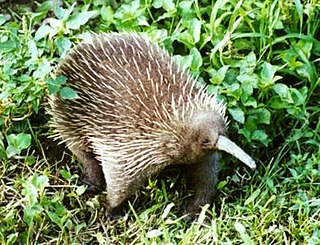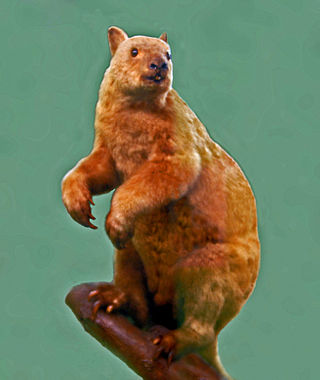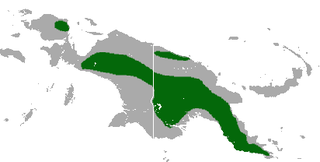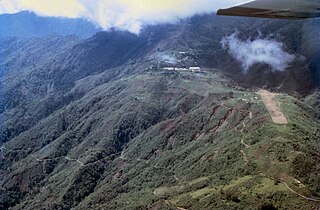
The Solomon Islands rain forests are a terrestrial ecoregion covering the Solomon Islands archipelago.

The long-beaked echidnas make up one of the two extant genera of echidnas: there are three extant species, all living in New Guinea. They are medium-sized, solitary mammals covered with coarse hair and spines made of keratin. They have short, strong limbs with large claws, and are powerful diggers. They forage in leaf litter on the forest floor, eating earthworms and insects.

The dingiso, also known as the bondegezou or bakaga, is an endangered, long-tailed marsupial found only in mountain forests on the west of the island of New Guinea. It is a species of tree-kangaroo, which are mammals native to Australia and New Guinea that feed on leaves or other plant matter. It belongs to the macropodid family (Macropodidae) with kangaroos, and carries its young in a pouch like most other marsupials. Though sacred to the local Moni people, it is still threatened by hunting and habitat loss.
The earless water rat is a New Guinea rodent, part of the Hydromys group of the subfamily of Old World rats and mice (Murinae). It is the only species in the genus Crossomys. This species is probably most closely related to Baiyankamys. It is still unclear to which species this group is related. It is one of the most aquatically adapted rodents of the world.
The Torricelli Mountains are a mountain range in Sandaun Province, north-western Papua New Guinea. The highest peak in the range is Mount Sulen at 1650 meters. The Bewani Mountains are located to the west, and the Prince Alexander Mountains are located to the east. To the north, the mountains slope down to the Pacific Ocean, and to the south lies the basin of the Sepik River. Named after the Italian physicist and mathematician Evangelista Torricelli during the German colonial period.

Hydromys is a genus of semiaquatic rodents in the subfamily Murinae. Three species are endemic to New Guinea and nearby islands. The fourth species, the rakali, is also found on Australia. The most recently discovered member of this genus was described in 2005.

Doria's tree-kangaroo is a long-tailed, furry, bear-like mammal found only in tropical mountain forests on the island of New Guinea. It is one of the largest tree-kangaroos, living alone in trees and active at night to feed on leaves or fruit. It belongs to the macropod family (Macropodidae) with kangaroos, and carries its young in a pouch like other marsupials. Threats include hunting and habitat loss.
Shaw Mayer's water rat is a semiaquatic species of rodent in the family Muridae. It is found in the mountains of Papua New Guinea.

The long-footed water rat is a species of rodent in the family Muridae. It is found in the mountains of southern Papua New Guinea. Its natural habitat is subtropical or tropical dry forest.

The black-tailed dasyure is a species of marsupial in the family Dasyuridae.

The grizzled tree-kangaroo is a furry, long-tailed, bear-like mammal native to tropical rainforests on the island of New Guinea. Like most tree-kangaroos, it lives in trees and eats leaves, fruit, and bark. It is a member of the macropod family Macropodidae with kangaroos, and carries its young in a pouch like other marsupials. The tree-kangaroo is uncommon and threatened by hunting and habitat loss. It is found in foothill forests of northern and western New Guinea and is indigenous to some of the offshore islands.

The ground cuscus is a marsupial from the order Diprotodontia and belongs within the family Phalangeridae, a diverse family consisting of the other cuscus species and the brushtail possums and the scaly-tailed possum.

The northern common cuscus, also known as the gray cuscus, is a species of marsupial in the family Phalangeridae native to northern New Guinea and adjacent smaller islands, but is now also found in the Bismarck Archipelago, southeast and central Moluccas, the Solomons, and Timor, where it is believed to have been introduced in prehistoric times from New Guinea. It was formerly considered conspecific with the allopatric P. intercastellanus and P. mimicus.

The Central Range montane rain forests is a tropical moist forest ecoregion on the island of New Guinea. The ecoregion covers the Central Range of the New Guinea Highlands, which extends along the spine of the island. The montane rain forests of the ecoregion are distinct from the surrounding lowland forests, and are home to many endemic plants and animals.

The Huon Peninsula montane rain forests is a tropical moist forest ecoregion in New Guinea. The ecoregion covers the mountains of northeastern New Guinea's Huon Peninsula.

Dendrolagus notatus, the ifola or ifola tree kangaroo, is a species of marsupial in the family Macropodidae. It is endemic to Papua New Guinea where it is found in high elevations of the central mountains. It is threatened by habitat loss and hunting for food with dogs by local people. The species is usually considered a subspecies of Dendrolagus dorianus but has recently been considered as a separate species by Helgen in 2007.

Baiyankamys is a genus of amphibious murid rodents. It was originally described, along with the species Baiyankamys shawmayeri by Hinton in 1943 after he found the remains of a single individual in south east of the Bismarck Mountain Range, north east New Guinea. Tate, in 1951 and, Laurie and Hill in 1954, confirmed the existence of both the species and genus.
Dollman's melomys is a species of rodent from the family Muridae. It lives in the eastern highlands of Papua New Guinea at an elevation of at least 1,200 metres (3,900 ft) and on the slopes of Mount Hagen and Mount Sisa. However, it is not found east of the Okapa area. It is an arboreal species occurring in montane secondary and degraded forest, preferring moist tropical environments. Formerly considered to be a subspecies of the black-tailed mosaic-tailed rat, the Dollman's melomys is also often listed as its binomial synonym, Melomys gracilis. The melomys is listed as Least Concern by the IUCN Red List due to its wide range, lack of threats, and tolerance of disturbance.
The Papua grassland mosaic-tailed rat, also known as the grassland melomys, is a species of rodent in the family Muridae. It is endemic to the island of New Guinea where it is present from sea level to altitudes of about 2,200 metres (7,200 ft). It inhabits grassland, gardens and other disturbed areas.

The Yapen rain forests is a tropical moist forest ecoregion in Indonesia. The ecoregion covers the island of Yapen and smaller neighboring islands which lie north of New Guinea.















